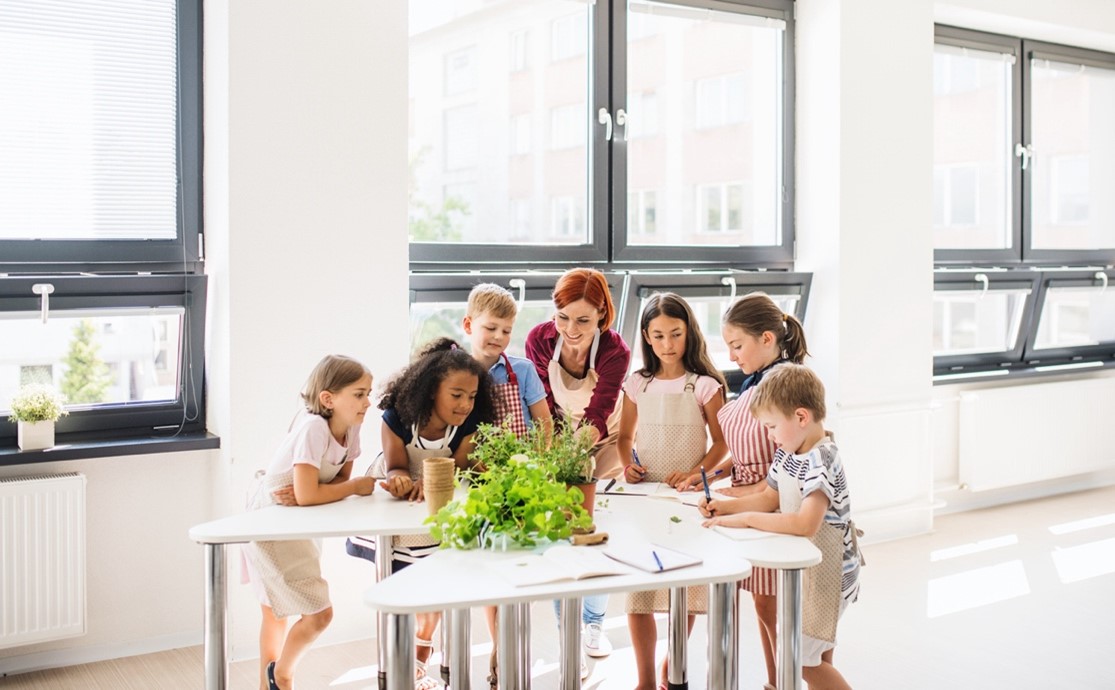As the educational landscape continues to evolve, the importance of designing inclusive learning spaces that cater to the needs of neurodiverse students has become front of center for many districts. PBL is a collaborative approach to education that can be effective for students of varied ages and abilities.
In the realm of education, the shift towards PBL has been gaining momentum as a dynamic approach to engage students in hands-on, real-world experiences. At the heart of this innovative method lies the physical environment in which learning takes place. Designing a school environment that supports project-based learning is not just about aesthetics, but about creating a vibrant and collaborative space that nurtures creativity, critical thinking, and collaboration among students of all ages.
For facility and school planners looking to design PBL collaborative spaces that accommodate neurodiversity, here are six key ideas to consider at the elementary, middle, and high school levels.
1. Provide Flexible Furniture and Layouts: One of the fundamental principles of designing inclusive learning spaces is flexibility. By incorporating adjustable furniture and adaptable layouts, schools can create environments that can easily be customized to meet the diverse needs of students. At the elementary level, consider using modular furniture that can be rearranged to accommodate different group sizes and activities. In middle and high schools, provide a variety of seating options, such as standing desks, bean bags, and ergonomic chairs, to cater to different sensory preferences and comfort levels.
2. Use Sensory-Friendly Design Elements: Sensory sensitivity is a common characteristic among neurodiverse students, so incorporating sensory-friendly design elements is essential. At all levels, consider using soft lighting, calming colors, and acoustical panels to create a soothing and comfortable environment. Provide designated quiet areas with noise-canceling headphones or soundproofing materials for students who need a break from sensory stimulation. Additionally, incorporate natural elements like plants and outdoor views to promote a sense of calm and connection to nature.
3. Incorporate Clear Visual Cues and Organization: Visual supports are invaluable for neurodiverse students, as they can help with orientation, communication, and task completion. At the elementary level, use visual schedules, pictorial labels, and color-coded materials to assist students in understanding routines and transitions. In middle and high schools, provide clear signage, visual aids, and digital displays to support organization and wayfinding. Consider incorporating visual timers, checklists, and task boards to help students stay on track and manage their time effectively.
4. Provide Multi-Sensory Learning Opportunities: Neurodiverse students often benefit from hands-on, experiential learning experiences that engage multiple senses. At all levels, design collaborative spaces that offer a variety of materials, textures, and tools for students to explore and manipulate. Provide sensory bins, fidget tools, and tactile surfaces to accommodate different sensory preferences and promote active engagement. Incorporate technology, such as interactive whiteboards and virtual reality tools, to enhance learning experiences and cater to diverse learning styles.
5. Create Supportive Community Spaces: Creating a sense of community and belonging is essential for neurodiverse students to thrive in their learning environments. At the elementary level, design shared spaces, such as reading nooks, art corners, and sensory rooms, where students can socialize, relax, and recharge. In middle and high schools, establish student-led clubs, mentorship programs, and peer support groups to foster connections and promote inclusivity. Encourage collaboration and teamwork through group projects, peer tutoring, and community service initiatives that allow students to work together towards common goals.

6. Bring the Outdoors in: It is best practice to incorporate elements of nature indoors and provide easy access to outdoor spaces that can be incorporated into the functional application of school work.1 Nature can enhance well-being and offer additional learning opportunities, benefiting not only neurodivergent learners but enriching the educational experience for the entire student body, highlighting the universal benefits of inclusivity and accommodation.
Fostering a sense of community is at the core of project-based learning. The school environment plays a crucial role in building this sense of community among students, teachers, and parents. Collaborative projects that involve multiple grade levels create opportunities for students to learn from one another and develop empathy and respect for different perspectives. School-wide events, such as exhibitions, celebrate student achievements and promote a culture of sharing and collaboration. This highlights the importance of creating community gathering spaces that have sensory adjustable elements such as dimmed lighting, sound absorbing fabrics, and easily accessed quiet areas that individuals can use to take a break.
Designing inclusive learning spaces for neurodiverse students requires thoughtful planning, creativity, and a deep understanding of diverse learning needs. It is imperative to collect feedback from neurodiverse students and the wider community to provide valuable insights into accessibility needs and areas for enhancement. Through incorporating flexible furniture, sensory-friendly design elements, visual supports, multi-sensory learning opportunities, and supportive community spaces, facility and school planners can create collaborative environments that empower all students to succeed in project-based learning. By embracing neurodiversity and prioritizing inclusivity in educational design, we can facilitate learning spaces that celebrate the unique strengths and abilities of every student.
Let’s cultivate a collaborative haven where students can learn, create, and grow together. This will shape the future of education and empower the next generation of innovators and problem-solvers.
- Kuo, M., Dettweiler, U., Faber Taylor, A., Jordan, C., & Wells, N. M. (2023). Editorial: Nature-based learning and development: maximizing the returns on investment, volume II. Frontiers in psychology, 14, 1304644. https://doi.org/10.3389/fpsyg.2023.1304644










